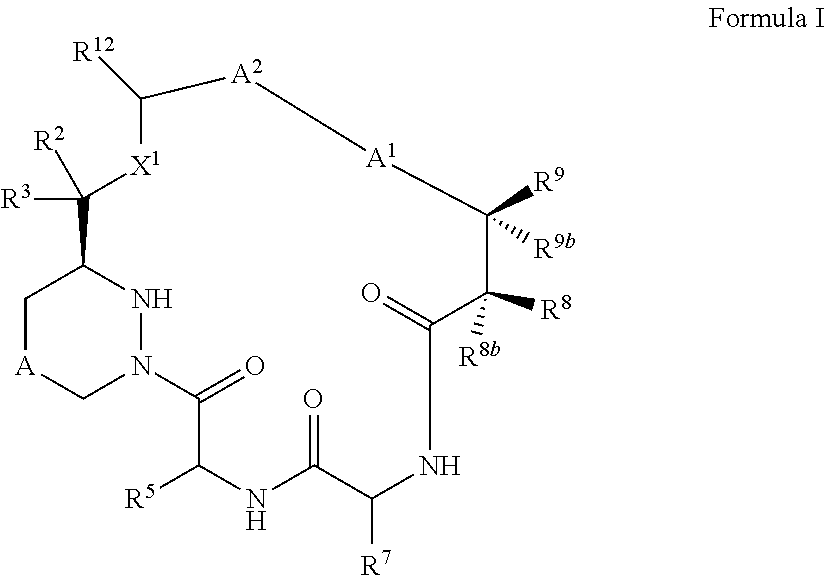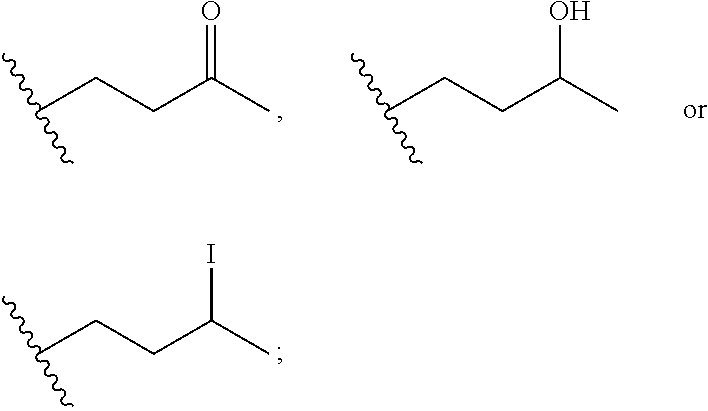Macrocyclic inhibitors of flaviviridae viruses
a technology of flaviviridae virus and macrocyclic inhibitor, which is applied in the direction of peptides, drug compositions, peptides, etc., can solve the problems of significant toxicity, inability to reduce viral rna levels, and ineffective ribavirin alone in reducing viral rna levels, so as to reduce viral load or clearance of viral rna
- Summary
- Abstract
- Description
- Claims
- Application Information
AI Technical Summary
Benefits of technology
Problems solved by technology
Method used
Image
Examples
example i
Compound I: (13E,15E)-(3S,6S,21S)-3-(3-Hydroxy-benzyl)-6-isopropyl-19-oxa-1,4,7,25-tetraaza-bicyclo[19.3.1]pentacosa-13,15-diene-2,5,8,20-tetraone
[0194]Prepared as described in J. Am. Chem. Soc. 2003, 125, 3849.
[0195]1H NMR (300 MHz, d6-DMSO) δ9.09 (s, 1H), 7.88 (d, J=7.9 Hz, 1H), 7.71 (d, J=8.4 Hz, 1H), 6.96 (app t, J=7.7 Hz, 1H), 6.65-6.51 (m, 3H), 6.00 (app pentet, J=13.0 Hz, 2H), 5.70-5.49 (m, 3H), 4.89 (d, J=11.5 Hz, 1H), 4.24-4.06 (m, 3H), 2.76-2.56 (m, 3H), 2.43-2.25 (m, 3H), 2.07-1.94 (m, 2H), 1.93-1.75 (m, 2H), 1.73-1.12 (m, 10H), 0.85 (d, J=6.9 Hz, 3H), 0.82 (d, J=6.9 Hz, 3H). LCMS (m / z) 555.3 [M+H], 577.1 [M+Na], Tr=4.45 min.
[0196]A solution of tripeptide 2a (5.46 g, 7.4 mmol), prepared as described in J. Am. Chem. Soc. 2003, 125, 3849, in 50 mL anhydrous CH2Cl2 was cooled to 0° C. and treated with 10 mL TFA. After 24 h at 0° C., 30 mL of dry toluene was added to the reaction mixture and the volatiles were removed in vacuo. The TFA ammonium salt was isolated as a foam and...
example iii
Compound 3: (13E,15E)-(3S,6S,9R,10R,11S,12S,21S)-3-(3-Hydroxy-benzyl)-6-isopropyl-10,12-dimethoxy-9,11-dimethyl-19-oxa-1,4,7,25-tetraaza-bicyclo[19.3.1]pentacosa-13,15-diene-2,5,8,20-tetraone
[0197]
(S)-1-{(S)-2-(S)-2-tert-Butoxycarbonylamino-3-methyl-butyrylamino)-3-[3-(tert-butyl-dimethyl-silanyloxy)-phenyl]-propionyl}-hexahydro-pyridazine-3-carboxylic acid but-3-enyl ester (3a)
[0198]
[0199]A solution of 2a (1.891 g, 2.562 mmol) in 50 mL THF was successively treated with Zinc (3.685 g, 56.368 mmol) and a solution of ammonium acetate (2.962 g, 38.430 mmol) in 10 mL water. After 24 h at RT, the mixture was filtered through a pad of Celite and rinsed with pH 4 solution (KHSO4). The aqueous layer was extracted with EtOAc (3×50 mL) and the organics were combined, dried (Na2SO4) and filtered. The volatiles were removed in vacuo and the residual AcOH was azeotroped with toluene (3×50 mL). The acid 2f was isolated as a white solid and used without further purification. The acid 2f was partia...
example iv
Compound 4: (13E,15E)-(3S,6S,9R,10R,11S,12S,21S)-3-(3-Hydroxy-benzyl)-6-isopropyl-10,12-dimethoxy-9,11-dimethyl-1,4,7,19,25-pentaaza-bicyclo[19.3.1]pentacosa-13,15-diene-2,5,8,20-tetraone
[0205]
((S)-1-{(S)-2-((S)-3-But-3-enylcarbamoyl-tetrahydro-pyridazin-1-yl)-1-[3-(tert-butyl-dimethyl-silanyloxy)-benzyl]-2-oxo-ethylcarbamoyl}-2-methyl-propyl)-carbamic acid tert-butyl ester (4a)
[0206]
[0207]A solution of 2a (1.370 g, 1.855 mmol) in 30 mL THF was treated with NaHCO3 (623 mg, 7.420 mmol) and 3-butenylamine hydrochloride (400 mg, 3.711 mmol). After overnight stirring, the reaction mixture was filtered through a pad of silica which was eluted with EtOAc. The volatiles were removed in vacuo to provide desired amide 4a (1.4 g, quant.) as a white solid. 1H NMR (300 MHz, d6-DMSO) δ7.87 (t, J=5.5 Hz, 1H), 7.67 (d, J=8.6 Hz, 1H), 7.08 (app t, J=7.9 Hz, 1H), 6.81 (d, J=6.8 Hz, 1H), 6.79 (d, J=6.9 Hz, 1H), 6.70-6.57 (m, 3H), 5.84-5.69 (m, 1H), 5.43 (td, J=4.2, 8.8 Hz, 1H), 5.09-4.90 (m, 3H), 4.0...
PUM
| Property | Measurement | Unit |
|---|---|---|
| Inhibition | aaaaa | aaaaa |
| Inhibition | aaaaa | aaaaa |
| Inhibition | aaaaa | aaaaa |
Abstract
Description
Claims
Application Information
 Login to View More
Login to View More - R&D
- Intellectual Property
- Life Sciences
- Materials
- Tech Scout
- Unparalleled Data Quality
- Higher Quality Content
- 60% Fewer Hallucinations
Browse by: Latest US Patents, China's latest patents, Technical Efficacy Thesaurus, Application Domain, Technology Topic, Popular Technical Reports.
© 2025 PatSnap. All rights reserved.Legal|Privacy policy|Modern Slavery Act Transparency Statement|Sitemap|About US| Contact US: help@patsnap.com



